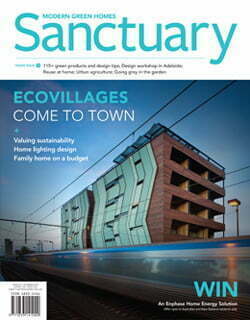Farming on the fringe
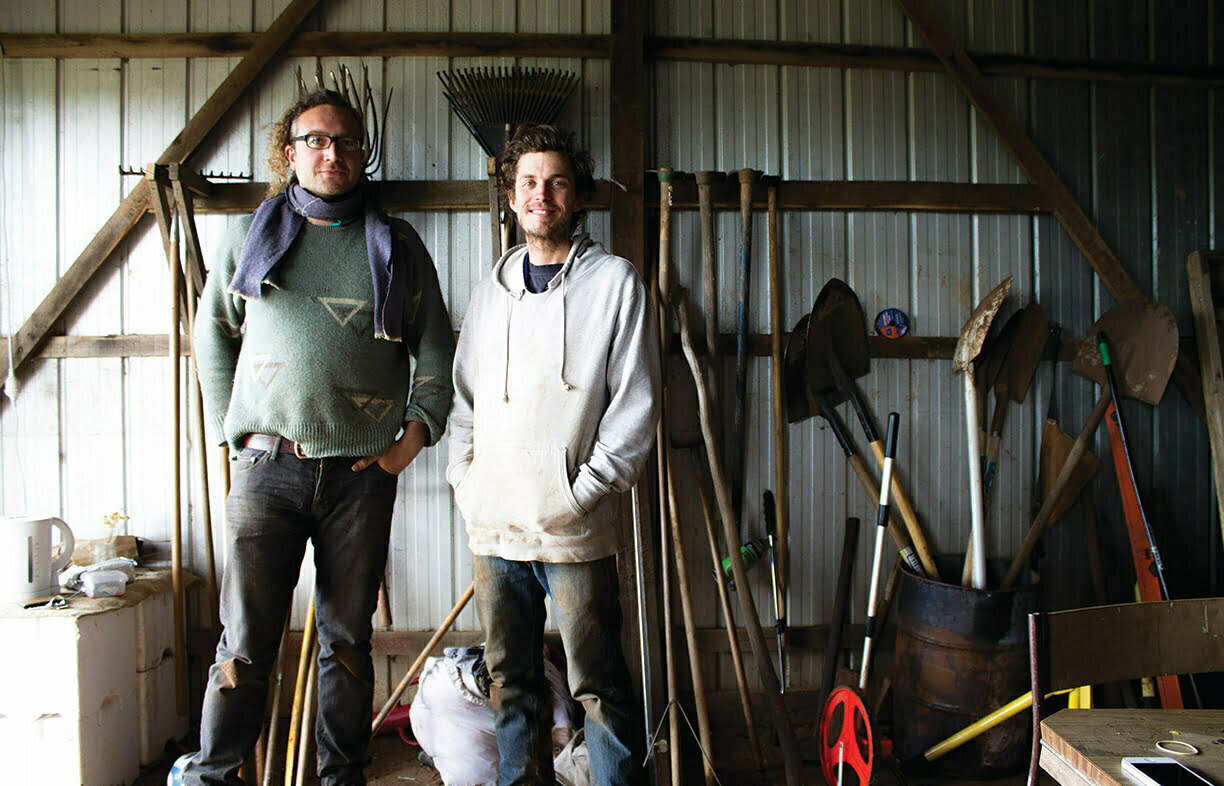
Australia’s rising city-based population coupled with a growing interest in food miles has led to fertile conditions for urban agriculture. Sarah Coles meets some of those farming on the fringe.
With its highly fertile, alluvial, river flat soils, Keilor is a hybrid landscape of suburban development and farmland, the ideal location for Paul Miragliotta’s foray into organic urban agriculture. He founded Day’s Walk Farm in 2014, set on 16 rolling acres on the Maribyrnong River, and just 22 kilometres from Melbourne’s CBD.
With a background in community garden projects and re-localised food production, Paul hit the ground running with the support of fellow landscape gardener Richard Morell. Rich works on the farm two days a week and has fond memories of the farm his grandfather tended for a Lord in the south of England. Rich and Paul (pictured above) met when they were working as landscape gardeners, where they bonded over similar plans to move into independent food production, “When we were landscaping we just talked about farming,” Paul says as we sit down to a lunch of chilli beans, cheese, homemade radish pickles and burnt “farmer’s coffee”.
Paul names “cutting travel time” as one of the key advantages of farming on the fringe. For example, Paul picks broccolini in the morning, which he delivers the same day to Neighbourhood Wine in North Fitzroy, where it is served that night to the hungry punters. “That’s the Day’s Walk difference,” he says, grinning as he cuts off a big chunk of blue cheese.
Looking out from the garlic beds, you can see fields of ripening broad beans, potatoes, spinach, chard, Asian greens, beehives, native shrubs which serve as windbreaks and habitat for wildlife, and lupins – a plant that fixes nitrogen into the soil, acting as an alternative to fertiliser.
A question that comes up a lot is whether it is possible to grow food in the city on the scale required to sustain our growing population. “The whole idea of cities is that they are supported by the hinterland and they can’t exist without that,” says Adam Grubb, Director of Very Edible Gardens, an urban permaculture consultancy. “But there is evidence the urban and peri-urban fringe could become self-sufficient in vegetables.”
Day’s Walk Farm benefits from the mentoring of the steward of the land, Steve Skopilianos, a third generation farmer whose grandfather started the Keilor farm in 1946. On the day that I visit, Steve is showing Paul how to lay irrigation driplines. Steve, who now runs an organic produce store, admires the diversity of Paul’s crops. His family were organic farmers too, but they would plant just one single crop across the whole farm. By contrast, Day’s Walk Farm has dozens of species at all times of the year.
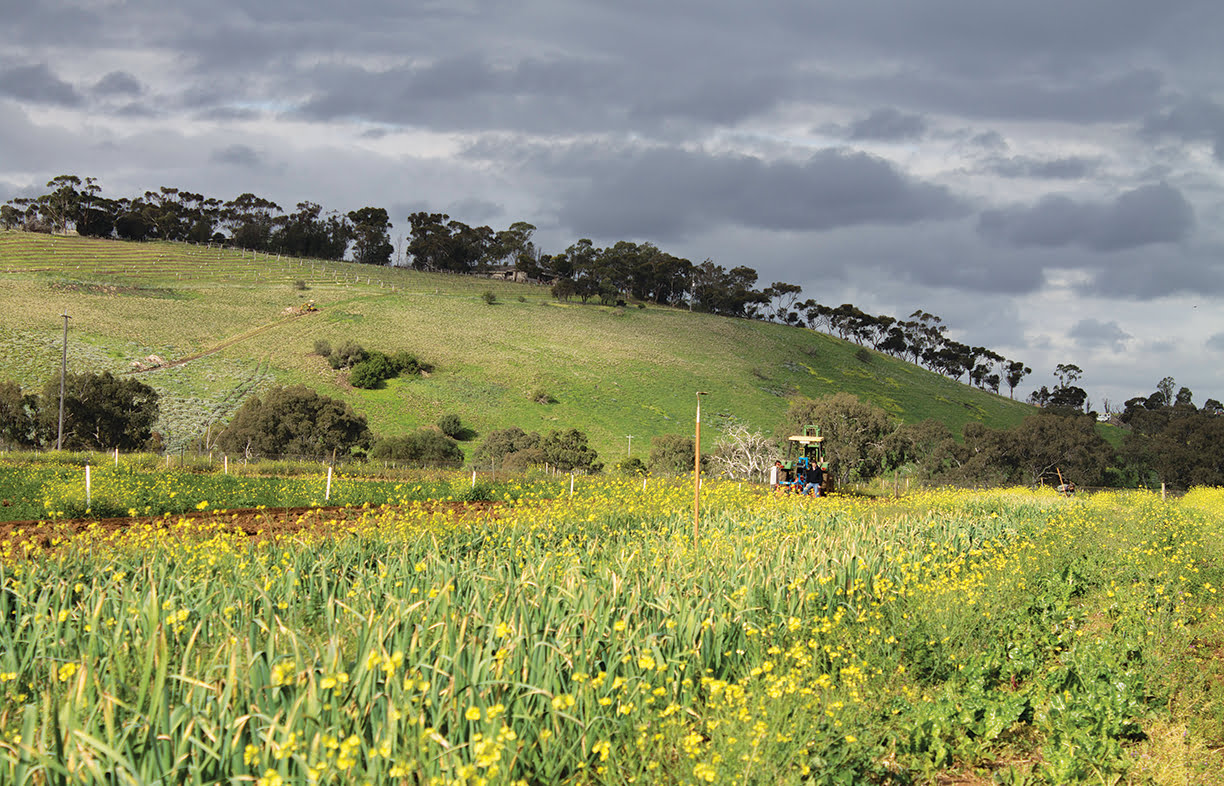
Steve laughs when I ask him about farming on the city fringes. “Up until 20 years ago Keilor wasn’t the fringe. People used to say to us, ‘Oh we had our honeymoon in Keilor.’ It wasn’t always in the city. Even in the late 80s, no one ever came out here unless they took the Old Calder on the way to Bendigo.”
Paul has a theory: “Generally, vegetables in the supermarket are not great quality – the flavour, nutritionally and so on,” he says. “A long shelf life and appearance have been prioritised in the breeding – vegetables like peas with natural sugars that deteriorate into starch in a short time are not in the supermarkets because they rely on a longer shelf life for saleability, for example”.
The nutrient density of produce from farms such as Day’s Walk is most likely higher than supermarket produce. Studies have shown a significant loss of nutrients in the time it can take a vegetable to make it from farm to table. When a vegetable is picked this initiates an enzymatic process which is detrimental to nutrients such as vitamin C and thiamine.
This could be one reason that demand for locally grown, fresh produce is on the rise. Kate Dundas, founder of 3000 Acres, a group which unlocks urban land for community food growing projects says, ‘‘People are looking for ways to re-engage with nature, and food is an easy access point to do this.” Rich says the tomatoes you get at the supermarket now are often bred for transport and to not bruise “whereas some of the heirloom tomatoes are really soft and there is a really short window of being ripe before they spoil – my Mum grows tomatoes in New Zealand and it’s just like eating fruit, they’re just so sweet you can eat them like a peach,” Rich says as he munches down on a radish.
Tomatoes are Paul’s favourite thing to grow. Paul, Rich and fellow farmer Angus Henderson will run ‘pick your own tomato’ days next summer in a project they have dubbed ‘The Pomodoro People.’ When I arrive Paul is in the back paddock preparing the ground for over 30 different varieties of tomato that Rich has germinated from seed. “We’ve got quite a few paste and sauce tomatoes because that’s what people like,” Rich says “And all of the strange and weird and colourful ones – a couple of really rare ones too, which will be good. We’ll be sick of tomatoes by the end of summer.”
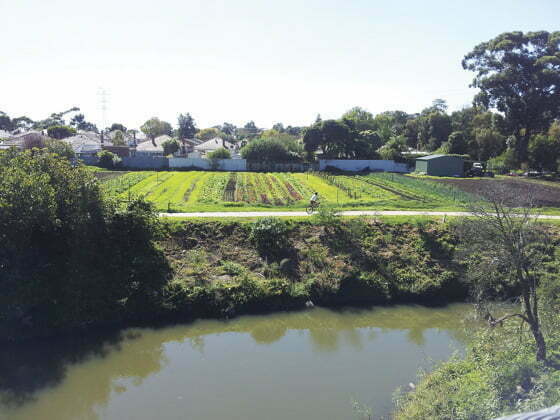
The Harding Street Market Garden is a 2.5 acre organic farm nine kilometres north of Melbourne CBD in the suburb of Coburg. The farm has been there since the mid 1800s, when it was a Chinese market garden. In 1945 an Italian family began farming there and now it is under the care of Centre for Education and Research in Environmental Strategies (CERES).
Chris Ennis, manager at Fair Food CERES, recognises that urban agriculture will not be able to replace traditional methods, but says our cities could grow certain crops at high enough levels, such as greens, beetroot, potatoes and onions. He says one advantage of farming close to the city is ready community engagement. “People passing the Harding Street Market Garden stop and call out and say hello and want to know about it all the time,” he says. Food from the farm is picked and sent to CERES market two kilometres away on the same day, where it is sold at the market or put into Fair Food vegie boxes. This quick turnaround reduces refrigeration and transport and ensures optimum freshness.
The farm boasts myriad sustainability features. Rainwater is harvested from the roofs of nearby townhouses to fill a 100,000 litre underground water tank. Chris lists farming techniques typical of organic farming such as composting, mulching and crop rotation. Food waste from CERES is composted here. Volunteers from the corporate world come and work at the farm. “We get them out of the offices and get them dirty and grounded and real,” Chris boasts. Inoculating city dwellers is a really big part of what we do. We’re not just growing food, we’re connecting people.”
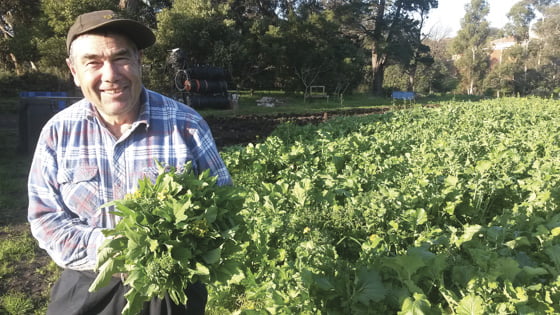
TO LEARN MORE VISIT:
Pomodoro People
Farmer Incubator
Harding Street Market Garden
3000 Acres
The One Straw Revolution
URBAN FARMS AROUND AUSTRALIA
2 & 5, Northern suburbs of Geelong, VIC
Wagtail Urban Farm, Adelaide, SA
Perth City Farm, Perth, WA
Turner Garden, Canberra, ACT
Hobart City Farm, Hobart, TAS
Northey Street City Farm, Brisbane, QLD
Aweganic Gardens, Darwin, NT
More stories you might like
 Outdoors
Outdoors
Saving stormwater
You can do a lot around your house to prevent stormwater runoff, simply by opting for permeable surfaces when landscaping.
Read more Outdoors
Outdoors
Swimming sustainably
Australian homeowners have increasingly been turning to natural pools as an eco-friendly alternative to traditional swimming pools. Jacqui Hagen dives in.
Read more Outdoors
Outdoors
Sweet spot: Sustainable midrise for healthy, nature-positive communities
An alternative to both highrise living and urban sprawl, well-designed medium density is the way to go for balancing the needs of people and nature, says ecologist Sarah Bekessy.
Read more

